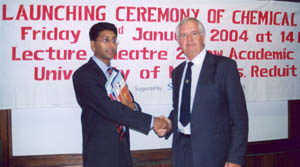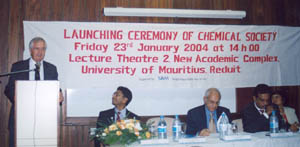Vol.
26 No. 3
May-June 2004
A New Society Aims High for its Island Nation
and the Indian Ocean Region
by Dhanjay Jhurry
Mauritius was dependent on agriculture and, in particular, on the sugar industry for many decades. In 1982, the country began a shift toward a more industrialized economy and placed major emphasis on developing the textile industry. Now, the government of Mauritius has decided that to keep pace with globalization, it is necessary to radically transform its economy from low-/medium-tech manufacturing to high-tech industries such as information and communications technologies, biotechnology, and pharmaceuticals. With this new focus on technology, the science literacy of the population will be a key element in the successful implementation of the government’s policies.
 |
CSM President Dhanjay Jhurry with IUPAC
Past-President Pieter Steyn. |
The development of a high-tech sector in Mauritius makes it clear that science is everybody’s business. Therefore, scientists have an obligation to explain the reality of science to society. Conscious of the important role of scientists, a group of chemists at the University of Mauritius founded a chemical society in June 2003, a first of its kind in Mauritius. The society was duly registered in Mauritius in October 2003. The society is a member of IUPAC as an Associate National Adhering Organization (ANAO) and is also affiliated with the Network of Users of Scientific Equipment of Southern Africa.
The Chemical Society’s official launching ceremony was held on 23 January 2004 in the presence of distinguished local and overseas guests, including IUPAC Past-President Pieter Steyn. A number of persons both from academia and industry were offered honorary membership on the occasion. They were selected by virtue of their contributions to the development of chemistry and science in Mauritius.
The support of IUPAC has given a boost to the society at the national and international levels. As Professor Steyn stated at the event, “the Chemical Society of Mauritius is like a newborn baby that should be nurtured to help it grow strongly and healthily.”
The purpose of the Chemical Society, which comprises chemists from all sectors, is to promote chemistry—in its broadest definition—within the Mauritian community. The society also aims to be a link between university research and the Mauritian chemical industry. In addition, the society also hopes to promote the sciences in general by making the public conscious of the power and value of scientific ideas.
Now that the society is an ANAO of IUPAC, it intends to join hands with the international chemistry community and help with IUPAC’s diverse projects and engage in new programs. The society hopes that a larger number of local researchers now will be able to attend international chemistry conferences because of reduced registration fees and possibly with support from IUPAC. It should be noted that Mauritian chemists are bilingual in French and English, a useful attribute for certain projects.
Chemists and all those involved with the chemical profession (from education to industry, including textiles and pharmaceuticals) and university students are invited to join the society to contribute to its development and to the advancement of chemistry.
Membership is not restricted to Mauritians. The society aims, in particular, to attract colleagues from the Indian Ocean region—La Réunion, Madagascar, Seychelles, and Comoros. It also plans to set up a database of chemists in the region. There are various types of membership (full, associate, student) and the membership fees vary from Rs 300 to Rs 900 (about USD 10 to 30). To date, the society has about 75 members and looks forward to doubling that number in a few months as more and more people come to know about its existence.
The society plan a number of activities throughout the year targeting students, teachers, people from industry, and the public at large. These will include roundtables, films, lectures by renowned chemists, short courses to meet industry’s needs, and organization of brainstorming sessions on topical issues.
 |
| IUPAC Past-President Pieter Steyn addressing the audience at the launching ceremony. Sitting from left to right: D. Jhurry (CSM president), Prof G. Mohamedbhai (vice chancellor, University of Mauritius), Dr. A. Suddhoo (executive director, Mauritius Research Council), and Mrs. C. Dupont (director, Curriculum, representing the Minister of Education & Scientific Research). |
Chemistry is a fascinating subject. It is by and large a creative process. Yet, very often students at the secondary level find it dull and at times too difficult. New teaching techniques have been and are being developed to address the problem. One of them is DIDAC, a joint effort of Agfa-Gevaert and the Belgian Academy of Sciences, which addresses the problem of visualization in chemistry. We would like secondary school teachers and students in Mauritius to benefit from these new techniques.
A major activity during 2004 will be the organization of a poster competition similar to the “It’s a Chemical World” contest organized by IUPAC and Science Across the World. The society has noted with concern that the Mauritian education system has led, over the years, to a cultural divide. Our idea is to impel those studying chemistry and the sciences, as well as students in the arts and the classics, to reflect on chemistry and to translate their feelings and observations into paintings.
Another very important activity will be a UNESCO School and IUPAC Conference on Biopolymers and Oriented Polymer Synthesis to be held in Mauritius in July 2005. It is hoped that a number of young scientists and graduate students from all over the world, and particularly from the African region, will attend.
It is an undeniable fact that societies have played a major role in the advancement of science all over the world. The Chemical Society of Mauritius hopes to play a major role as well. Dhanjay Jhurry <[email protected]> is president of the Chemical Society of Mauritius.
Page
last modified 23 April 2004.
Copyright © 2003-2004 International Union of Pure and
Applied Chemistry.
Questions regarding the website, please contact [email protected]
|